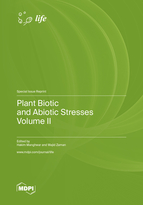Plant Biotic and Abiotic Stresses
A special issue of Life (ISSN 2075-1729). This special issue belongs to the section "Plant Science".
Deadline for manuscript submissions: closed (31 May 2023) | Viewed by 134939
Special Issue Editors
Interests: plant biology; plant stress physiology; plant resistance against different stresses; abiotic and biotic stresses; heavy metal stresses; phytohormones; plant autophagy; plant biotechnology; plant genome editing; CRISPR/Cas9; nanoparticles; plant-bacteria interaction
Special Issues, Collections and Topics in MDPI journals
Interests: plant systematics; medicinal plants; plant biodiversity; phylogenetics
Special Issues, Collections and Topics in MDPI journals
Special Issue Information
Dear Colleagues,
Plants under natural conditions often face multiple stresses, including drought, salinity, temperature extremes, submergence stress, bacteria, viruses, fungi, insects, etc. These biotic and abiotic stresses negatively influence plant growth and productivity. Recently, various approaches have been used to overcome stresses in plants. It is necessary to evaluate and explore how diverse molecular techniques can be applied to different biological studies for improving biotic and abiotic stress tolerance in plants. This will help reduce production losses and increase crop tolerance to various stresses. It is now the time to make a difference by developing plants that can withstand biotic and abiotic stresses.
Dr. Hakim Manghwar
Dr. Wajid Zaman
Guest Editors
Manuscript Submission Information
Manuscripts should be submitted online at www.mdpi.com by registering and logging in to this website. Once you are registered, click here to go to the submission form. Manuscripts can be submitted until the deadline. All submissions that pass pre-check are peer-reviewed. Accepted papers will be published continuously in the journal (as soon as accepted) and will be listed together on the special issue website. Research articles, review articles as well as short communications are invited. For planned papers, a title and short abstract (about 100 words) can be sent to the Editorial Office for announcement on this website.
Submitted manuscripts should not have been published previously, nor be under consideration for publication elsewhere (except conference proceedings papers). All manuscripts are thoroughly refereed through a single-blind peer-review process. A guide for authors and other relevant information for submission of manuscripts is available on the Instructions for Authors page. Life is an international peer-reviewed open access monthly journal published by MDPI.
Please visit the Instructions for Authors page before submitting a manuscript. The Article Processing Charge (APC) for publication in this open access journal is 2600 CHF (Swiss Francs). Submitted papers should be well formatted and use good English. Authors may use MDPI's English editing service prior to publication or during author revisions.
Keywords
- plant abiotic stress tolerance
- drought
- salinity
- cold
- heat
- submergence
- waterlogging
- heavy metals stress
- climate changes
- oxidative stress
- lighting damage
- plant biotic stress tolerance
- bacteria
- viruses
- fungi
- insects








